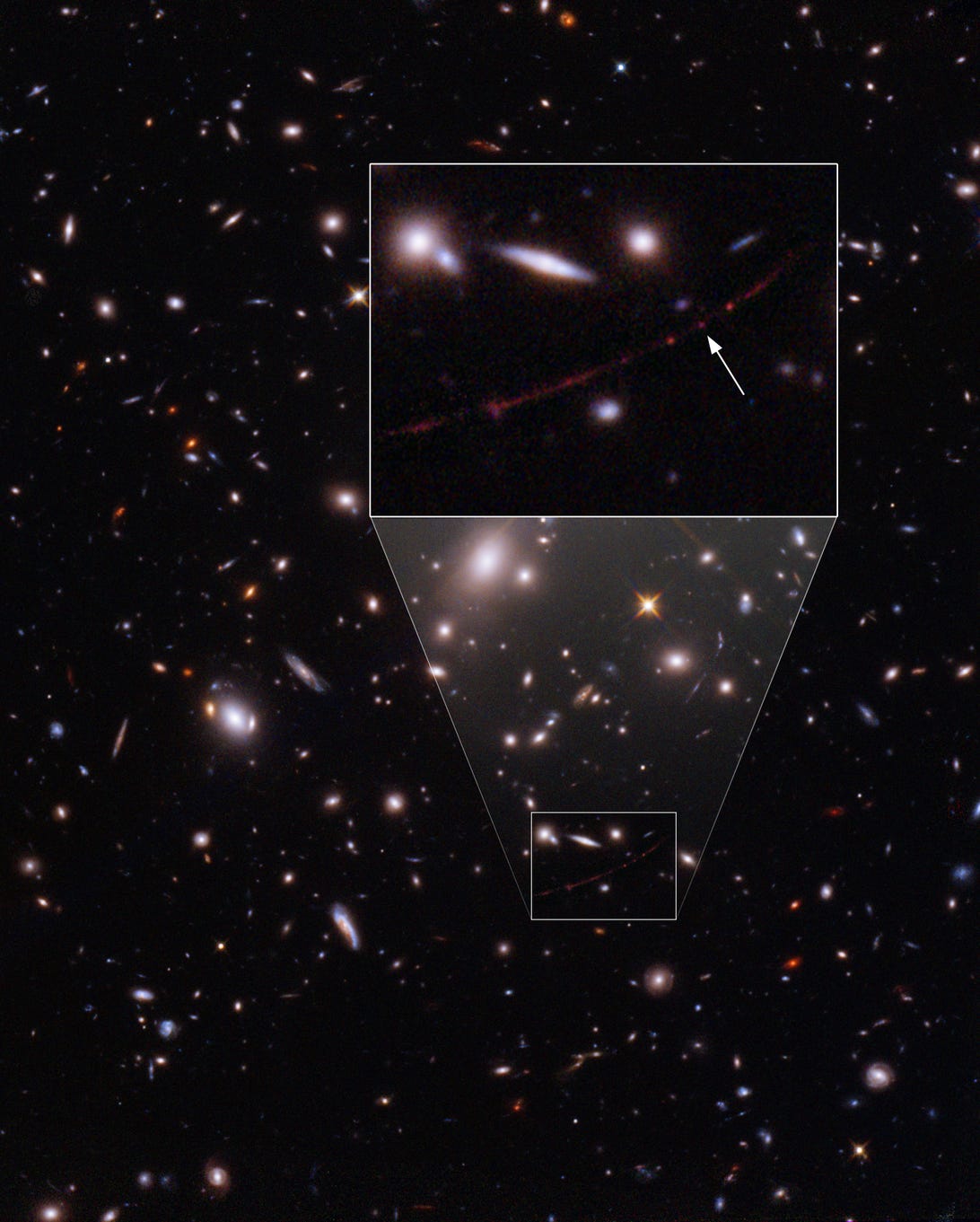
Earendel (indicated with arrow) is positioned together a ripple in area-time that provides it severe magnification, allowing it to emerge into see from its host galaxy, which seems as a red smear throughout the sky.
NASA, ESA, Brian Welch, Dan Coe
On Wednesday, NASA declared a discovery our minds can hardly fathom.
The Hubble Area Telescope noticed a star that’s at the very least 50 situations the mass of our sun, glows a number of million instances brighter and is nestled so completely deep in room that it took a colossal 12.9 billion years for its light to access Earth. It was born when the cosmos was at just 7 % its present-day age and, after accounting for the universe’s steady enlargement, presently floats 28 billion light-yrs absent.
This glimmering leviathan is the farthest, oldest single star ever seen by humankind.
And following some deliberation, scientists gave the cosmic artifact a somewhat touching name: Earendel, which usually means “early morning star” in Previous English.
“Researching Earendel will be a window into an era of the universe that we are unfamiliar with, but that led to everything we do know,” Johns Hopkins College astronomer Brian Welch reported in a statement. Welch is guide writer of a paper released Wednesday in the journal Mother nature that describes Earendel’s discovery.
But before we go any more into how this special star arrived in our line of eyesight, and what it can tell us about our previous, let’s set Earendel into viewpoint for our mere mortal brains.
Our sun is a whopping 109 occasions the dimension of Earth, and Earendel is involving 50 and 500 moments bigger than that. Our sunlight is nearly 93 million miles (149,669,000 kilometers) from us, nonetheless despite this distance, it’s the sole lightbulb managing to illuminate our entire environment. Earendel is tens of millions of situations brighter than our sunshine.
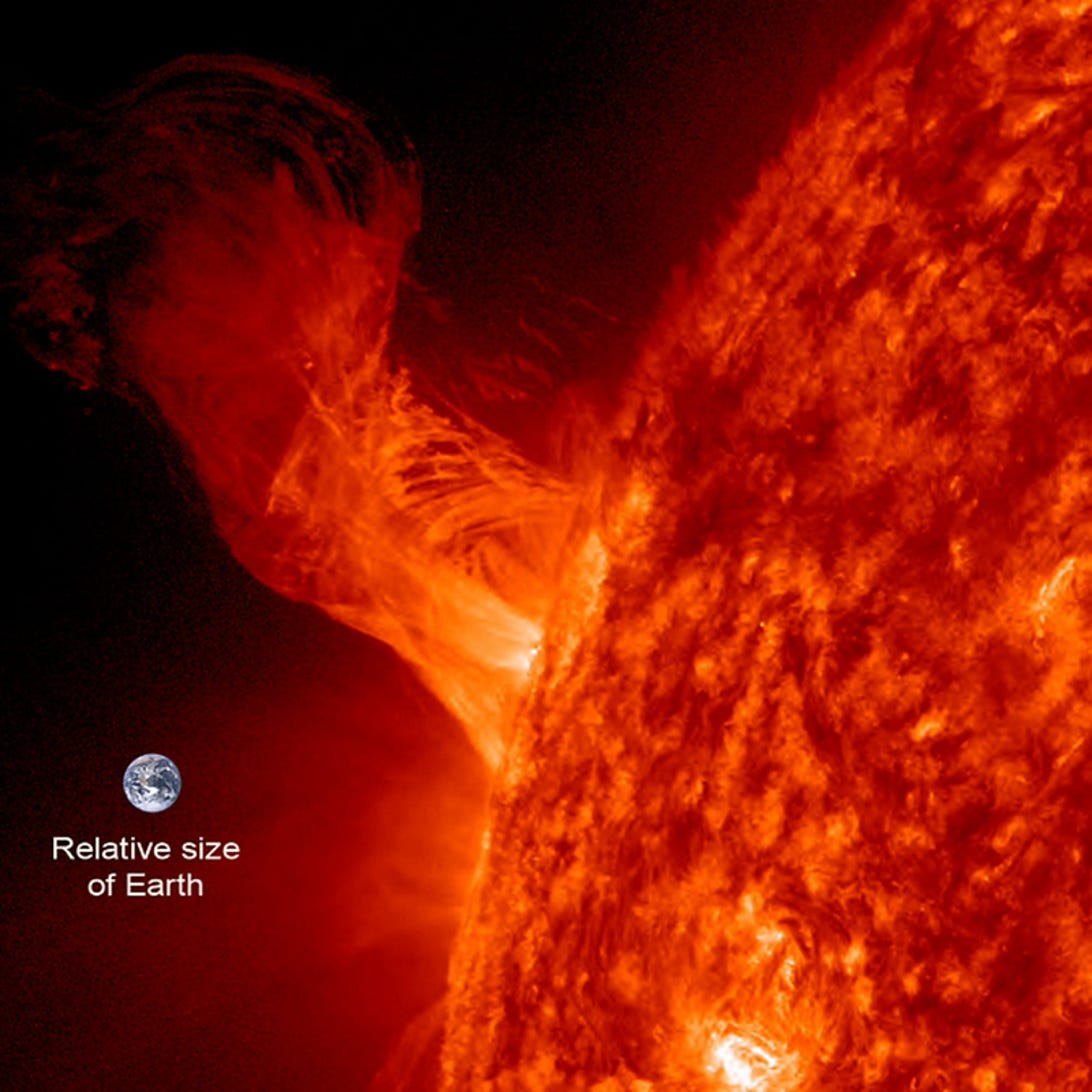
A dimension comparison of the Earth and sunlight. Wow.
NASA
And finally, the former distance-record-holding star, dubbed Icarus and found by Hubble in 2018, arrived into existence when the universe was at about 30 percent its current age it took 9 billion years for Icarus’ light to arrive at us. Earendel is a lot (substantially) more historical and distant than even that.
With Earendel, we’re on the lookout at light that originated just just after the Big Bang — photons that journeyed for numerous millenia to achieve human eyes.
“As we peer into the cosmos, we also glance back in time, so these serious higher-resolution observations enable us to have an understanding of the developing blocks of some of the really initially galaxies,” Victoria Strait, an astronomer at the Cosmic Dawn Center in Copenhagen and co-author of the analyze, claimed in a assertion.
Welch available a metaphor: “It really is like we have been looking through a seriously interesting e book, but we begun with the 2nd chapter, and now we will have a probability to see how it all obtained begun.”
Photographing a star 28 billion light-weight-decades absent
It sounds like a fable.
For Hubble to lay eyes on Earendel, a crowd of faraway galaxies needed to beautifully align and warp the fabric of room and time with extremely-significant precision.
“Usually, at these distances, whole galaxies look like smaller smudges, with the light-weight from tens of millions of stars blending collectively,” Welch stated. That’s why the staff was stunned to see a one star, Earendel, sticking out. But there Earendel was, thanks to a interesting phenomenon referred to as gravitational lensing. In a nutshell, here’s what that is.
In accordance to Albert Einstein’s idea of normal relativity, place and time are linked as a form of fabric. Super substantial objects in this material, like planets or black holes, make it morph, or warp, inward. Visualize positioning a fifty pound fat onto a trampoline the trampoline will warp inward and sort a curve. It truly is the same strategy.
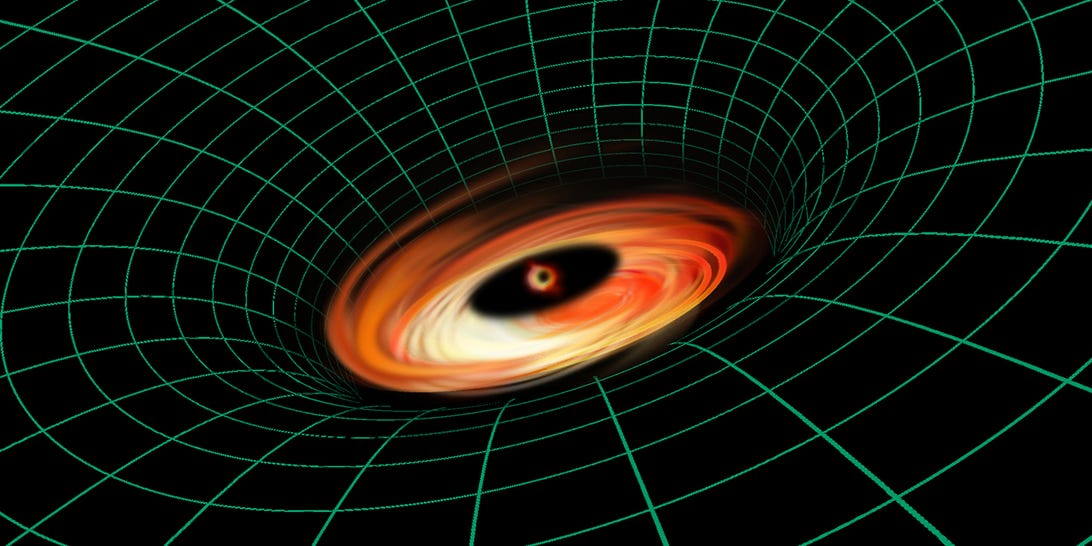
An illustration depicting how the fabric of place and time warps. Nevertheless, keep in head, this is a 2D image. In fact, this occurs in increased proportions, which our definitely tricky for our brains to understand.
NASA/ESA/A. Feild and L. Hustak (STScI)
And the much more significant the object, the even larger the curve. That’s why black holes are regarded as the product of the warping crop. But irrespective, the universe is filled with a bunch of these curves mainly because it has plenty of massive objects, and scaled-down objects are inclined to slide along all those curves.
For occasion, humans are presumably planted on Earth mainly because we’re slipping alongside Earth’s curve — in conditions of the trampoline analogy, we’re like 1 pound weights falling along the fifty pound weight’s curve. Einstein’s principle states that this falling-together-curves thought is what we understand as gravity, but returning to the wonder of Earendel, these curves also in some cases mess with our view of outer place.
Generally, when the most significant cosmic bodies come collectively, aka galaxy clusters, which keep billions of stars and several black holes, huge warping occurs, too. This mad warp is robust plenty of to influence mild nearby, thereby distorting and magnifying the luminescence of cosmic objects in the vicinity.
With just the human eye and a telescope, even a single like Hubble, these objects are just also far absent or faint to see, but after light-weight illuminating them is run by means of the cluster curve, they come into concentration. This is identified as gravitational lensing, and it is really how Welch and fellow scientists noticed Earendel.
“The galaxy internet hosting this star has been magnified and distorted by gravitational lensing into a long crescent that we named the Dawn Arc,” Welch said.
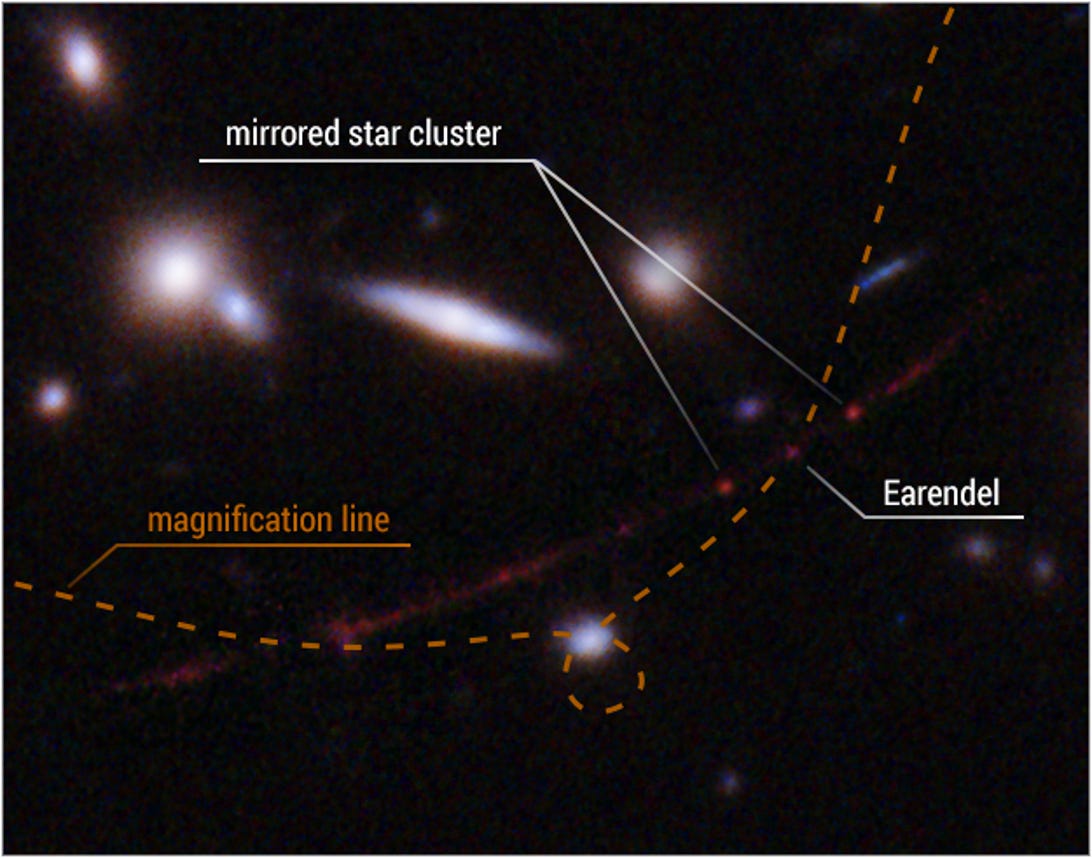
A near-up see of Earendel.
NASA, ESA, Brian Welch, Dan Coe
But potentially most astonishing in this discovery is that every galaxy cluster on the way to Earendel oriented itself in these types of a way as to warp the single star’s light-weight and make it stick out in the Sunrise Arc.
NASA phone calls it a stroke of luck.
NASA’s James Webb Telescope to review Earendel
Hunting to the foreseeable future, Earendel is variety of the fantastic issue for NASA’s James Webb Space Telescope, which released late last yr and is the agency’s stunning endeavor to picture the cosmos as they were right after the Large Bang. It truly is constructed to look at the universe across large timelines.
The equipment is armed with a very specialised toolkit that can detect photons from gentle-a long time on gentle-decades away, scan for possible alien life lurking in deep room, elucidate the origins of black holes and, relevantly to Earendel, analyze incredibly aged stars in unprecedented element.
“With James Webb, we will be in a position to confirm that Earendel is in fact just 1 star, and at the very same time quantify which type of star it is,” Sune Toft, chief of the Cosmic Dawn Center and professor at the Niels Bohr Institute, mentioned in a assertion. Toft participated in the Earendel examine.
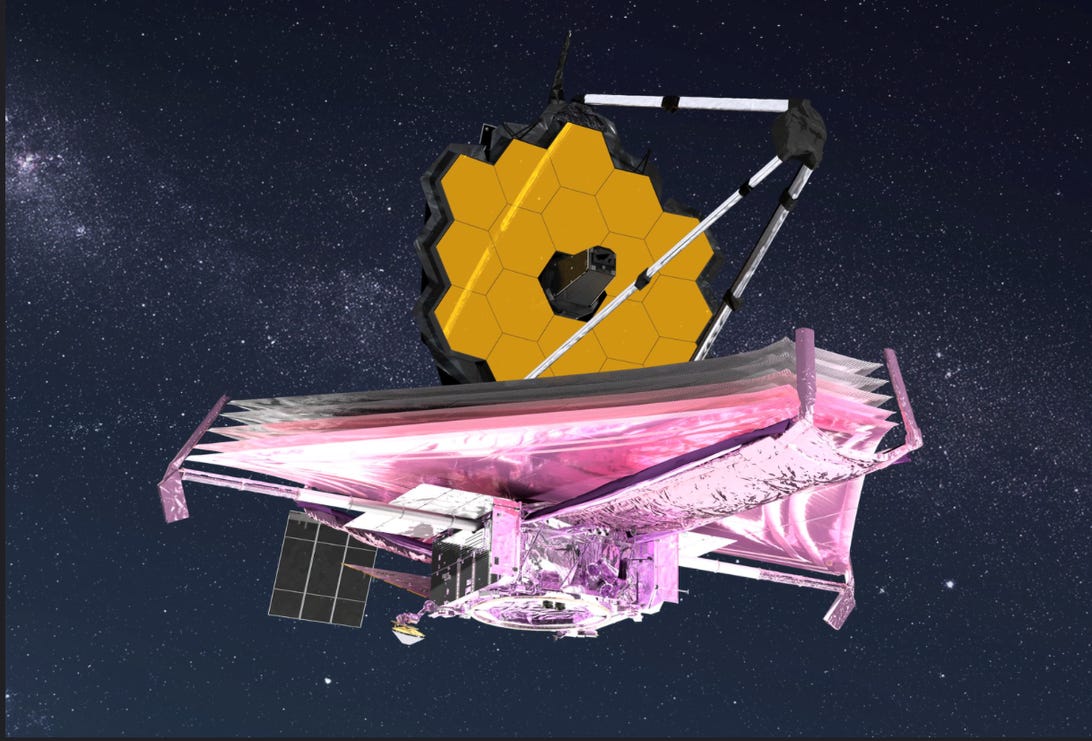
The James Webb Space House Telescope in an artist’s rendering.
NASA GSFC/CIL/Adriana Manrique Gutierrez
Webb’s devices could even drop gentle on Earendel’s chemical composition, which, per the scientists, could be the most significant deal of all.
At the time Earendel was born, the investigation team suggests, the universe wasn’t still loaded with the standard set of significant features that give increase to the stars nearer to us — youthful stars. “Earendel could be the initially acknowledged case in point of the universe’s earliest technology of stars,” Toft explained, and “this would suggest Earendel is a scarce, enormous metal-lousy star,” Dan Coe, an astronomer at the Area Telescope Science Institute in Baltimore and co-writer of the analyze, said in a statement.
But in the grand scheme of factors, Webb may possibly very well be a action forward.
If you remember, when the telescope blasted off, it left the entire world in a flurry of speculate simply because it can be poised to response concerns we might’ve never even thought to request and to obtain objects we could under no circumstances have dreamed of. “With Webb, we could see stars even farther than Earendel, which would be very fascinating,” Welch claimed. “We are going to go as far again as we can.
“I would like to see Webb split Earendel’s distance history.”
